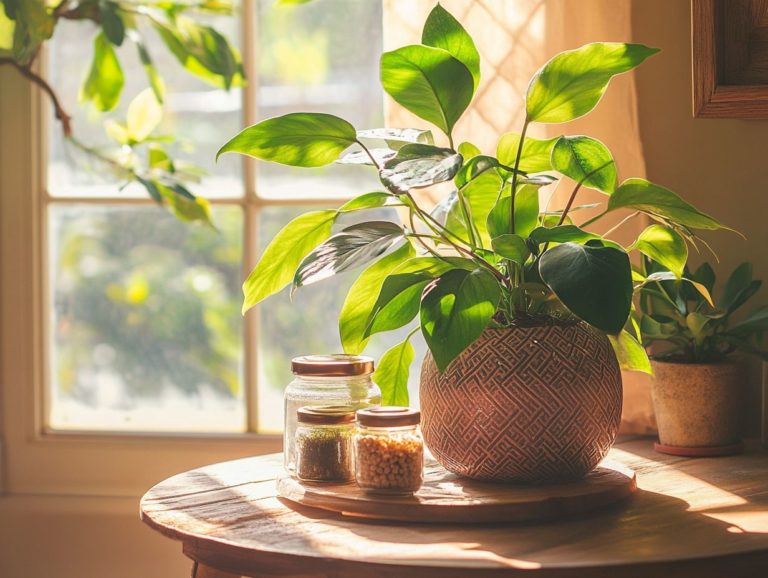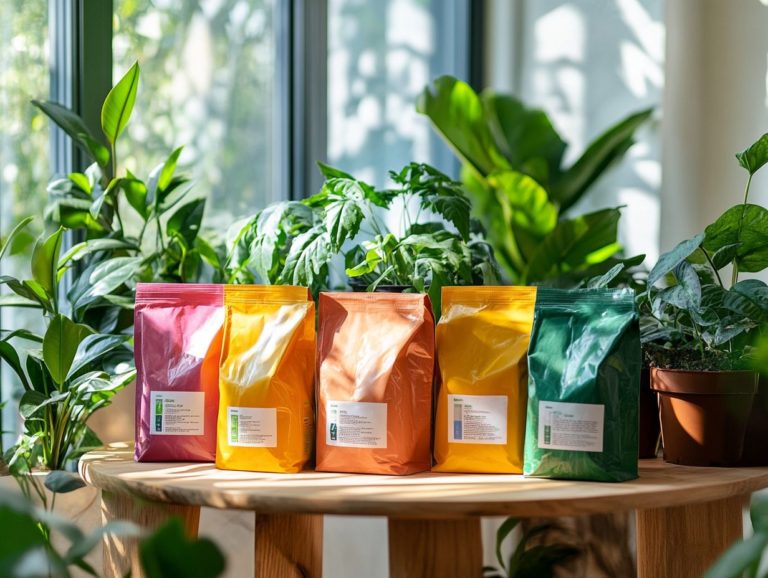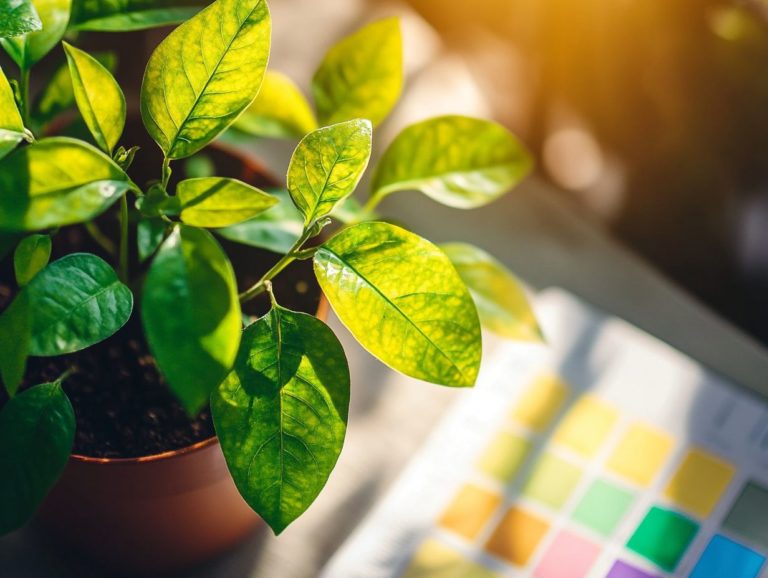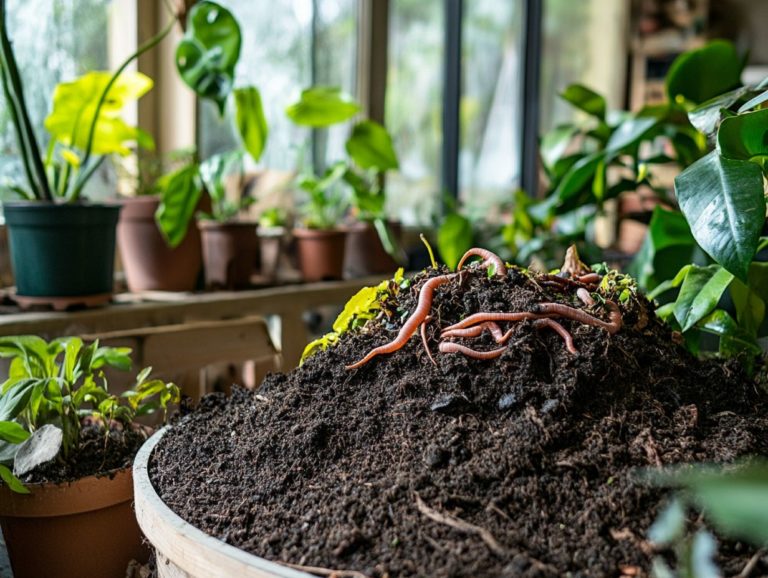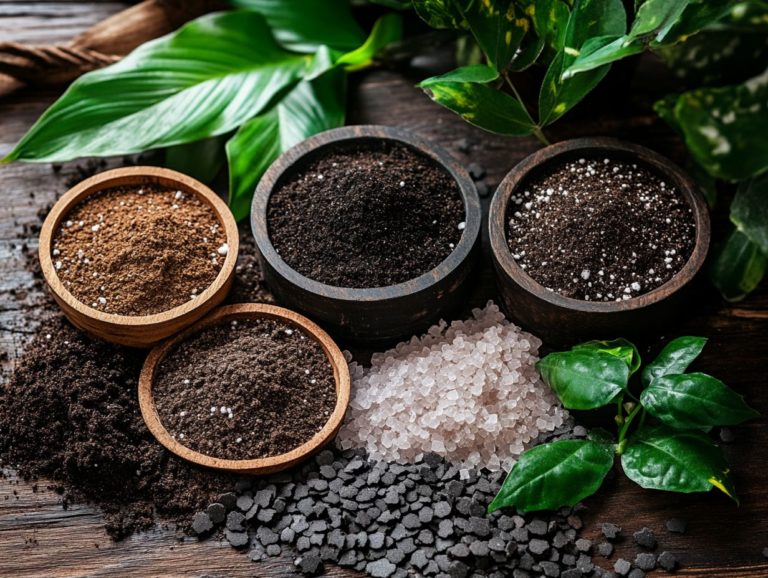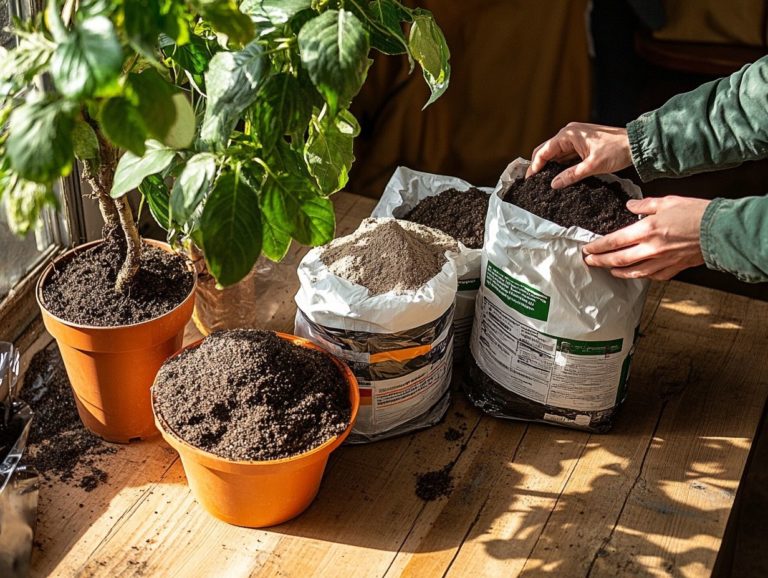How to Use Compost in Indoor Plant Soil
Are you aiming to enhance the health and vitality of your indoor plants? Compost could be the solution you ve been seeking.
This organic powerhouse enriches your soil with essential nutrients and improves drainage. You’ll discover the numerous benefits of compost, learn how to choose the right type for your specific needs, and receive practical steps for seamlessly incorporating it into your indoor plant soil.
You will also find valuable tips on maintaining your soil s nutrient balance and avoiding common mistakes. Get ready to transform your indoor garden into a vibrant oasis today!
Contents
- Key Takeaways:
- What is Compost and Why Use it in Indoor Plant Soil?
- Types of Compost and How to Choose the Right One
- Preparing Indoor Plant Soil for Compost
- Applying Compost to Indoor Plants
- Maintenance and Care with Compost
- Frequently Asked Questions
- What is compost and how is it beneficial for indoor plant soil?
- How do I use compost in my indoor plant soil?
- Can I use compost from my outdoor compost bin in my indoor plant soil?
- How often should I add compost to my indoor plant soil?
- Is it safe to use compost in all types of indoor plant soil?
- Can I use compost as the sole growing medium for my indoor plants?
Key Takeaways:

- Using compost in indoor plant soil provides numerous compost benefits, such as increasing nutrient content, improving soil structure, and promoting beneficial microorganisms.
- There are different types of compost available, so it’s important to understand the various composting methods and factors to consider when choosing the right one for your indoor plants.
- Properly incorporating and applying compost to indoor plant soil is crucial for its effectiveness. Regular maintenance and avoiding common mistakes can help maintain a healthy nutrient balance in the soil.
What is Compost and Why Use it in Indoor Plant Soil?
Compost is a remarkable organic material that breaks down naturally, serving as an invaluable asset for enriching the soil of your indoor plants. It elevates soil nutrition and structure, providing your houseplants with the essential nourishment they require to flourish.
Many gardeners, including Kathryn Kellogg from Going Zero Waste, advocate for incorporating compost into your indoor gardening practices to enhance root development and overall health of your houseplants.
Given its myriad benefits, compost emerges as a crucial element in indoor gardening, fostering a sustainable environment for your beloved indoor plants.
Benefits of Compost for Indoor Plants
The benefits of compost for your indoor plants are remarkable. Compost significantly enhances growth and health by improving soil nutrition and structure.
By incorporating compost into your potting mix, you ll witness impressive improvements in water retention. This allows your plants to stay hydrated longer an essential factor in indoor environments where moisture tends to evaporate quickly.
The enhanced nutrient availability from compost facilitates better nutrient uptake, resulting in more vibrant foliage and stunning blooms. The increased microbial activity in the soil fosters a thriving ecosystem that helps break down organic matter and improves soil aeration.
Utilizing techniques like compost tea not only enriches the soil but also delivers an immediate nutrient boost directly to your plant foliage and roots. Additionally, understanding the benefits of mulching indoor plant soil ensures your indoor plants thrive in their cozy quarters.
Types of Compost and How to Choose the Right One
Selecting the right compost for your indoor plants is essential for their growth. Different types of compost provide unique benefits tailored to your gardening approach, whether you re engaging in traditional composting or exploring the wonders of vermicomposting.
Understanding Different Composting Methods
Understanding different composting methods, such as traditional composting and composting with worms, is essential for gardeners. These methods directly influence the quality and nutrient content of the compost used in indoor plant soil.
Among the various techniques, traditional composting typically involves creating compost piles or bins. You layer organic waste think kitchen scraps and yard debris to decompose naturally over time. This tried-and-true method creates rich compost, but it requires regular turning to aerate and manage moisture levels.
On the flip side, there’s vermicomposting, which introduces red wiggler worms. These little powerhouses break down organic materials more efficiently, yielding an exceptional compost known as worm castings. While vermicomposting can deliver quicker results and a higher concentration of nutrients, it may not suit every climate and requires a bit more initial setup.
Each method has strengths and weaknesses. For instance, using coffee grounds in indoor plant soil can enhance compost quality and effectiveness in enriching your indoor plants.
Factors to Consider When Choosing Compost
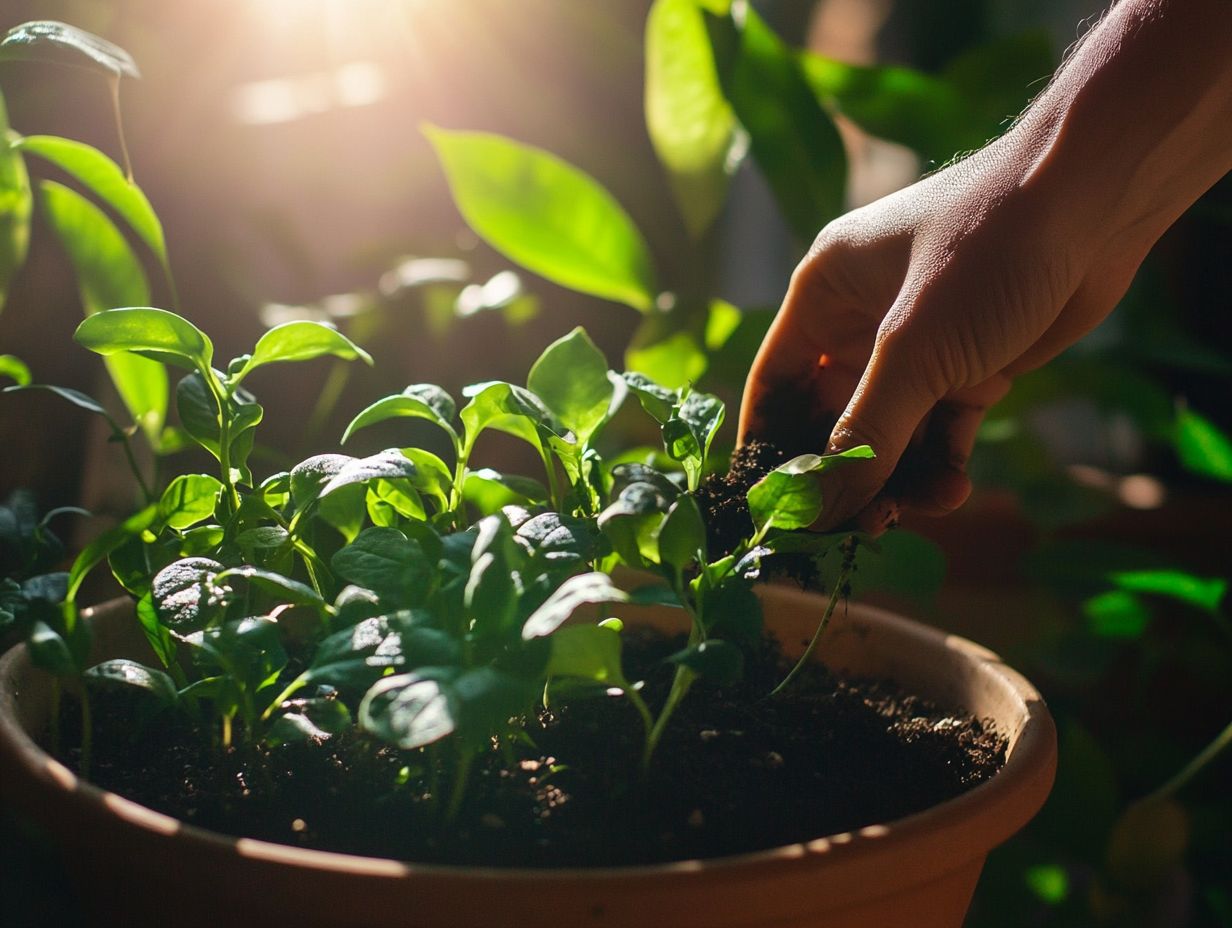
When selecting compost for your indoor plants, several crucial factors deserve attention: compost types, organic matter content, and the ideal compost ratio. These ensure your healthy plants receive optimal soil nutrition.
Understanding the source of organic matter is vital as it influences nutrient availability for plant growth. For example, compost from kitchen scraps may provide different advantages compared to that from yard waste. The nutrient content can vary considerably among compost types; some may be rich in nitrogen, while others maintain a more balanced profile of essential nutrients.
To achieve the best results, consider how each type of compost impacts plant health. Determining the right compost ratio for your various house plants is key; typically, a 1:1 mix of compost to potting soil works wonders. However, increasing the compost content for heavy feeders can significantly enhance growth and vigor. For more insights, explore the top soil amendments for healthy indoor plants.
Preparing Indoor Plant Soil for Compost
Preparing indoor plant soil for compost is a crucial step in cultivating a thriving environment for your plants. By ensuring that the soil structure and compost ratio are perfectly balanced, you set your plants up to thrive!
Steps for Incorporating Compost into Soil
Incorporating compost into your indoor plant soil is an elegant process that can significantly elevate plant health and improve soil quality.
First, recognize that compost serves as a nutrient-rich amendment, supplying essential elements that may be missing in your standard potting mix. Start by selecting a high-quality, well-aerated compost; this choice will lay the foundation for exceptional results.
Gently remove the top layer of the existing soil from your plant’s pot using a small shovel or hand tools, treating your plants with the care they deserve.
Aim for a compost-to-soil ratio of about one part compost to three parts soil, striking a harmonious balance to avoid overwhelming your plants. Once mixed thoroughly for even nutrient distribution, consider the timing of your application; early spring or your plant s active growing phase is ideal for reaping maximum benefits.
Finally, water your plants lightly to help the compost settle in and establish its roots.
Applying Compost to Indoor Plants
Properly applying compost to your indoor plants is essential for ensuring they enjoy the full spectrum of benefits. This includes enriched soil nutrition and enhanced plant growth, achieved through techniques like compost tea and direct application.
Act now to give your plants the best start!
Proper Techniques for Adding Compost to Soil
Using the right techniques to add compost to your soil is key to helping your indoor plants thrive.
Apply a thin layer of compost on top or mix it well with your soil. This boosts nutrient availability and helps retain moisture.
Be careful not to overdo it. Too much compost can suffocate roots and upset nutrient levels.
Watch how your plants respond. Adjust how much compost you use based on their health and growth.
Maintenance and Care with Compost
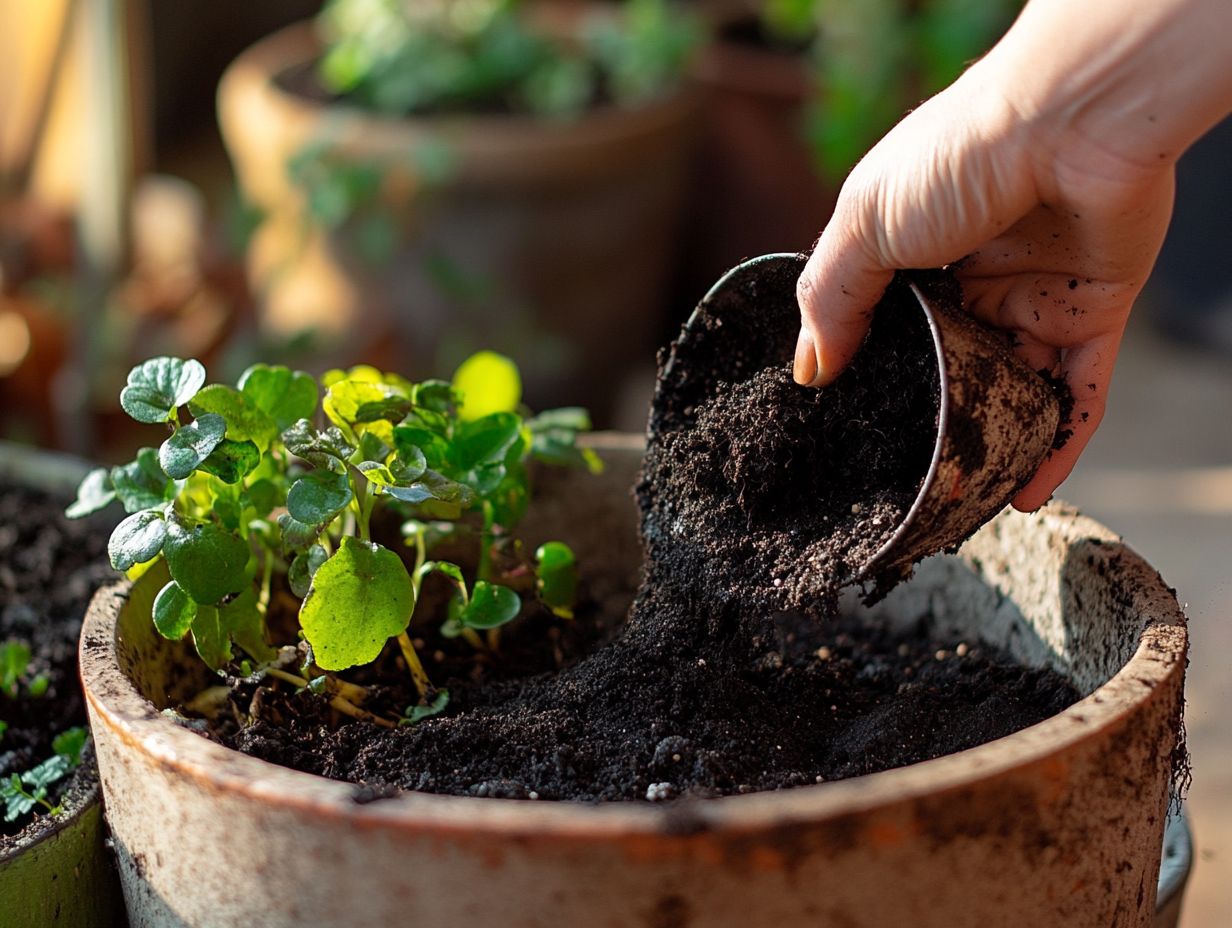
Using compost is a game-changer for your indoor plants! It sustains soil nutrition and helps your plants grow healthy over time.
Compost also enables you to manage organic waste effectively, creating a harmonious environment for both your plants and the planet.
How to Maintain Nutrient Balance in Soil
Maintaining nutrient balance in your soil is essential for your indoor plants health. You must understand their specific nutrient needs and apply effective compost methods, including using Compost Tea.
Regularly test your soil’s pH and nutrient levels to gain insights that guide adjustments. Home testing kits can be incredibly beneficial for assessing pH and identifying nutrient issues.
Once you gather this information, tailor your compost applications accordingly. Incorporate the right mix of organic matter to boost soil fertility and ensure essential nutrients are available for your plants.
This thoughtful calibration promotes optimal growth and enhances the overall vigor and resilience of your garden.
Common Mistakes to Avoid
Avoiding common mistakes when using compost can significantly improve the health of your indoor plants.
Many gardeners mistakenly believe that more compost equals better growth. This can lead to nutrient burn, which is when plants get harmed by too many nutrients, or poor drainage.
Neglecting soil structure can stifle root development and water retention, ultimately jeopardizing plant health. Another oversight is failing to consider the right compost-to-soil ratio, which can lead to imbalanced nutrient levels.
Apply compost sparingly and maintain a layered soil structure. Monitor the compost ratio closely to create a balanced blend that promotes robust plant growth.
Consider creating Compost Tea to further enhance nutrient availability for your House Plants.
Frequently Asked Questions
What is compost and how is it beneficial for indoor plant soil?
Compost is a nutrient-rich soil amendment made from decomposed organic materials, including organic waste from your kitchen. When used in indoor plant soil, it improves soil structure, increases water retention, and provides essential nutrients for healthy plant growth.
How do I use compost in my indoor plant soil?
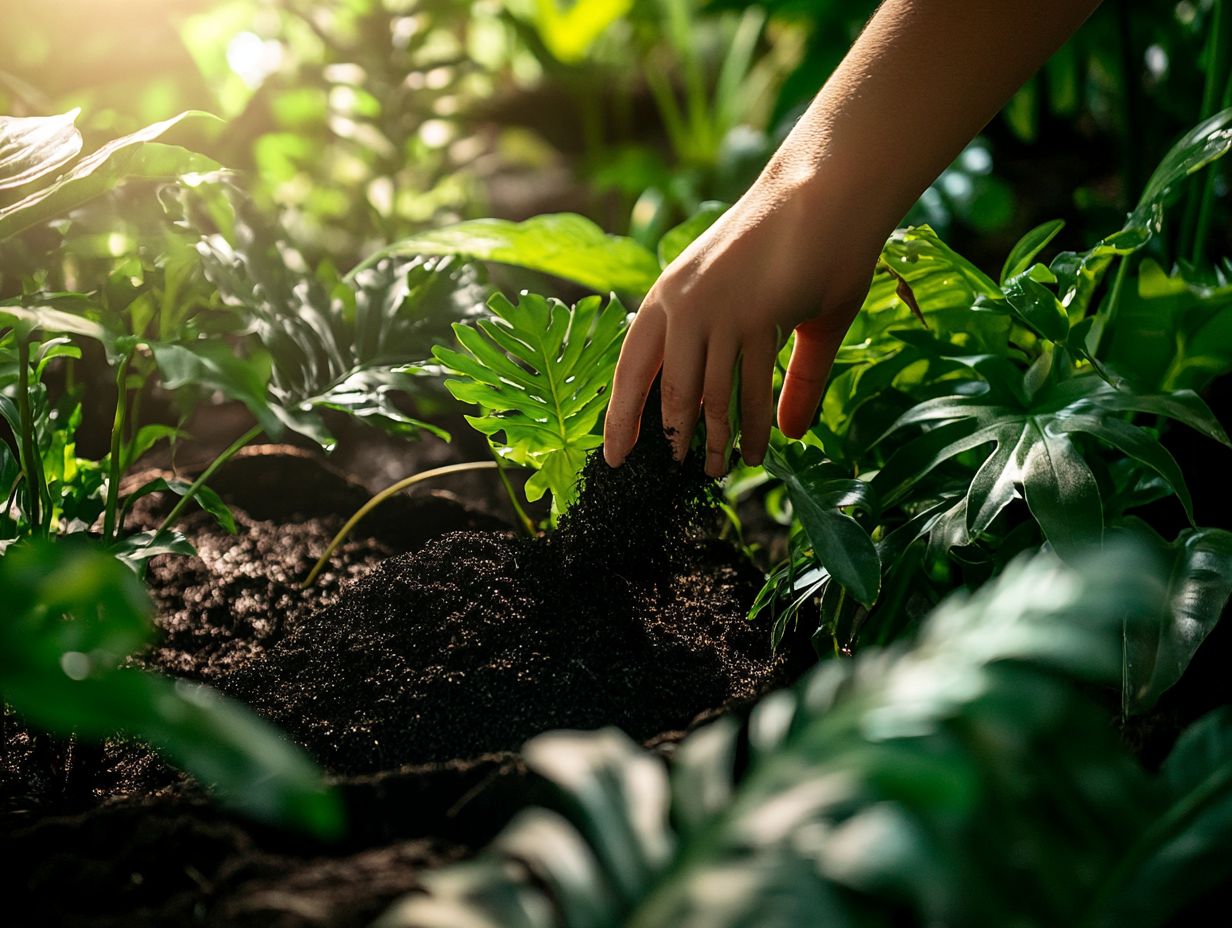
Start by mixing compost with your existing potting soil at a ratio of 1:3. This means one part compost to three parts potting soil. You can also use compost as a top dressing by sprinkling a thin layer on the soil’s surface and gently mixing it in.
Can I use compost from my outdoor compost bin in my indoor plant soil?
Using outdoor compost indoors isn t the best choice! It might have pests, weed seeds, or pathogens that can hurt your plants.
Instead, choose commercially produced compost or make your own compost specifically for indoor plants.
How often should I add compost to my indoor plant soil?
This varies based on your plants’ needs. Generally, adding compost once or twice a year is enough for most houseplants.
If you notice signs of nutrient deficiency, feel free to add compost more often.
Is it safe to use compost in all types of indoor plant soil?
Yes, compost is safe for all indoor plant soils, including potting mixes and specialized soils for specific plants like apple trees.
Just mix it in well and avoid using too much, as it can change the soil’s pH balance, which is how acidic or alkaline the soil is.
Can I use compost as the sole growing medium for my indoor plants?
No, compost alone isn t suitable for indoor plants like apple trees. It doesn t drain well and may compact over time.
Use compost as a soil amendment to boost soil health. For the best results, look for indoor compost blends that include other elements for better aeration.

